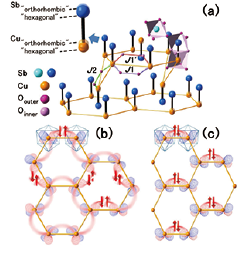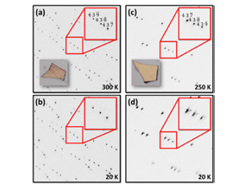Copper Oxide with No Static Jahn-Teller Distortion
N. Katayama, H. Sawa, and S. Nakatsuji
The quantum spin liquid (QSL) state has been intensively pursued since Anderson proposed the resonating valence bond model. For realizing a novel QSL state, orbital degree of freedom has been considered as a nuisance because orbital ordering usually appears at high temperature accompanying with a cooperative Jahn-Teller (JT) distortion and spin ordering. Therefore, the QSL candidates found so far have been mostly in spin only systems without orbital degree of freedom.

Fig. 1. (a) Schematic view of the local structure for hexagonal and orthorhombic samples. (b) Schematic picture of a non-cooperative static JT distortion. (c) and (d) Schematic pictures of spin-singlet formation in short-range honeycomb lattices of Cu2+ for (c) hexagonal and (d) orthorhombic samples.

Fig. 2. Single crystal x-ray diffraction profiles for (a-b) hexagonal and (c-d) orthorhombic samples. The insets in (a) and (c) are photographs of the transparent brown single crystals for the hexagonal and orthorhombic samples, respectively. The hexagonal samples are darker than the orthorhombic samples.
Perovskite-type 6H-Ba3CuSb2O9 is a novel candidate material for the spin-orbital liquid state, which we have reported recently [1]. In the material, spin-orbital short-range ordering occurs in the short-range honeycomb lattice of Cu2+ with eg orbital degrees of freedom, as shown in Fig.1(a). Powder x-ray diffraction experiment shows that even at low temperatures, the hexagonal components remain along with some orthorhombically distorted components. In the hexagonal phase, three-fold symmetry exists for the Cu2+ sites which are surrounded by octahedrally coordinated oxygen, indicating the absence of a cooperative JT distortion. To explain this unusual feature, we proposed two possible scenarios. (i) Orbital glass state with a non-cooperative static JT distortion. In this scenario, the local symmetry is lowered by a static JT distortion, as schematically shown in Fig.1(b), but the overall hexagonal symmetry remains. (ii) Spin-orbital liquid state. The static JT distortion is absent and instead, a dynamic JT distortion appears, leading to a novel spin-orbital liquid state, as depicted in Fig. 1(c). These two possible scenarios cannot be distinguished by experimental results using powder specimens alone. A thorough structural study using a single crystal without orthorhombic components is required.
Our progress in preparing single crystalline samples enabled us to obtain single crystalline samples without any orthorhombic components down to the lowest temperature. Figures 2(a) and 2(b) show single crystal x-ray diffraction experimental data. The peaks show no signs of splitting or broadening down to 20 K, the lowest temperature of our measurements (“hexagonal sample”). The hexagonal sample can be well refined by using the centro-symmetric space group P63/mmc for all temperatures. For P63/mmc, the three-fold symmetry is retained for Cu2+ sites, indicating the absence of the cooperative JT distortion. These observations are in sharp contrast with our previous single crystal x-ray diffraction study of 6H-Ba3CuSb2O9. There, we reported that the Bragg peak splits into several separate reflections upon decreasing temperature, as shown in Figs. 2(c) and 2(d). This result indicates that the hexagonal P63/mmc symmetry is lowered to the orthorhombic Cmcm symmetry (“orthorhombic sample”). We attribute this effect to a cooperative JT distortion induced by uniform ferro-orbital ordering of Cu2+ ions (Fig.1(d)).
While x-ray diffraction experiment gives us the averaged structural information, the electron spin resonance (ESR) enables us to study the local orbital configuration. Using the single crystals, we confirmed the isotropic g factors are realized within the in-plane directions in the hexagonal samples down to 3.5 K, clearly indicating that the non-cooperative JT scenario is not realized and instead, a dynamic JT distortion appears [2]. Further studies using the crystals will address the open questions on the quantum spin-orbital liquid state, such as the orbital dynamics and the mechanism to stabilize such an exotic liquid state.
References
- [1] S. Nakatsuji et al., Science 336, 559 (2012).
- [2] N. Katayama et al., Proc. Natl. Acad. Sci. USA, 112, 9305 (2015).
